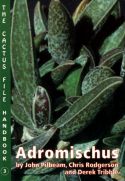INTRODUCTION
Please
update your old records now.
This is the Home
page for Adromischus Displayed,
a horticultural
reference
web site. It is
equivalent to a freely-distributed booklet
containing:
- Fifty-five
pages of brief, but original, Species information
with a distribution map and photograph
for all recognised taxa.
- Seventeen
pages answering frequently asked Questions about
cultivation, propagation,
relationships, etc. plus a Quiz.
- Six pages
of selected Links to reference
information about succulents and South
Africa.
- A page
listing New
Additions to this site.
As well as
people who enjoy growing succulent plants,
the selected links should interest
anyone wanting to visit Southern Africa or
study plants in greater depth.
Adromischus
(plural Adromischi, or Adro's for short)
are easily propagated, leaf succulents
from the Crassulaceae (Stonecrop)
family. Look closely at the diverse
range of leaf shapes, textures and
colours. They make good pot plants and,
being relatively small, a wide selection
can be grown in a modest space. All this
comes with the benefit of succulence -
watering can be infrequent.
|
|

This
web
site displays only a small
part of what you will find
in The
Adromischus
Handbook, by
John Pilbeam, Chris
Rodgerson and Derek Tribble.
|
|
Hooray for the Internet! With this
technology, we can easily share pictures and thus
make plant identification easier. Would you have
recognised this description as Adromischus hemisphaericus from the words alone?
"The fourth sort grows naturally at
the Cape of Good Hope. This hath a thick succulent
stalk, which rarely rises above a span high,
dividing into many branches, garnished with short,
thick, succulent leaves, which are very convex on
their under side, but plain on their upper, not
more than half an inch long, and a quarter broad,
of a grayish colour spotted over with small green
spots, and fit close to the branches : the
foot-stalks of the flower rise from the top of the
branches, and are six inches, long, naked, and
support five or six flowers, which come out
alternate from the side, sitting very close to the
stalks ; they are tubular, and cut into five parts
at the top ; these are greenish, with purple tips.
It flowers in June, and July, but never produces
seeds in England."
Philip Miller wrote this in his
famous "Gardener's Dictionary", 8th Edition (1768),
admittedly before specialised botanical terminology
had been defined.
|